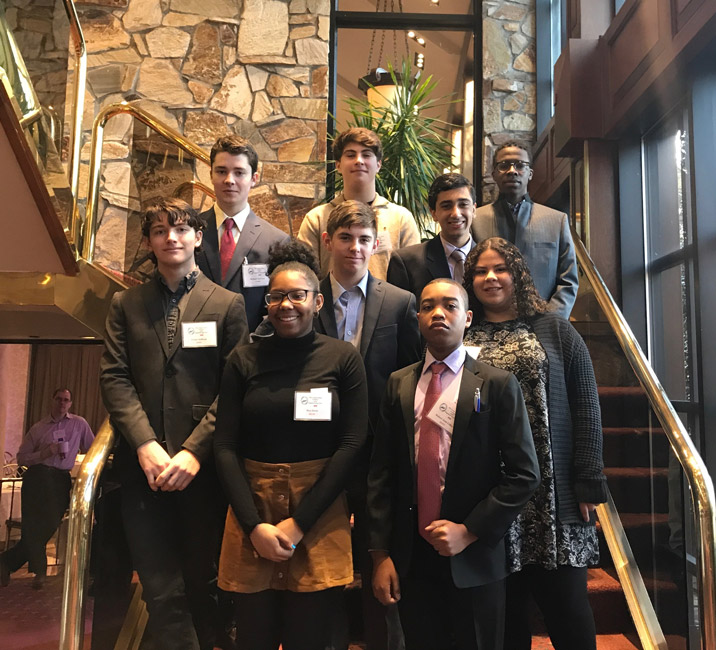Huntington High School’s science research program sent a high-powered group of nine students to the junior varsity division of the Long Island Science & Engineering Fair at Crest Hollow Country Club in Woodbury.
Zubair Ali, Terrel Cox, Maya Davis, Matthew Gennarelli, Robert-Jean Gilles, Michael McCooey, Samuel Roberts, Foster Sullivan and Claudia Villatoro were accompanied by science teachers Lori Kenny and Dame Forbes. The two faculty members guided and mentored the students while the teenagers developed their projects.
Many of Long Island’s leading high school students participated in this year’s competition. “The Charles Duggan Long Island Science and Engineering Fair is a competition for the most advanced high school projects,” according to the LISEF website. “The participants in this fair have a chance to present to professionals in their subject areas from local universities, scientific institutions and professionals in the field.”
The Huntington scholars presented their research findings to judges known for their high standards. The projects were well-received and some of the teenagers endured multiple rounds of judging, which required them to be articulate, informed and able to converse intelligently about all aspects of their work.
“I was judged twice and both judges were interested and gave me back positive feedback and ideas for my project next year,” said Ms. Villatoro, a sophomore. Some members of the Huntington contingent returned to the high school from Crest Hollow with a resolve to further develop their research while others were inspired to pursue new project avenues and categories.
Huntington students have a long tradition of participating in the LISEF and through the years have won numerous honors in every contest category.
Mr. Ali, an exceptional sophomore captured honorable mention honors for his project on the “Effect of Propylene Glycol Propyl Ether on Uca pugnax.
“It was such a competitive fair that I wasn’t expecting to get an award, but I am extremely proud of myself for accomplishing this,” Mr. Ali said.
The Effect of Propylene Glycol Propyl Ether on Uca pugnax
By Zubair Ali
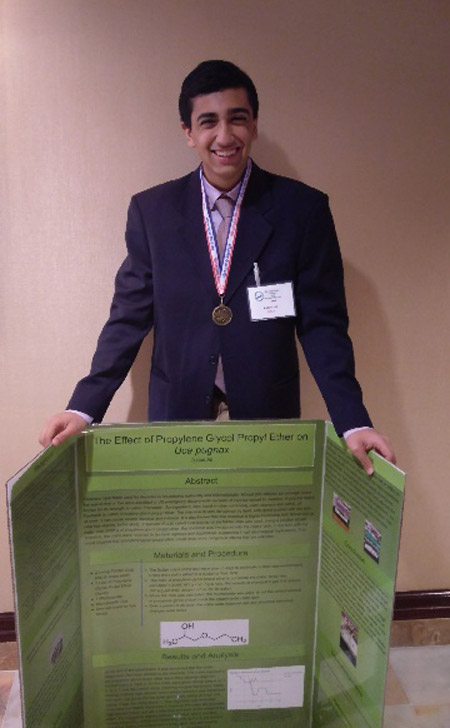
Zubair Ali with his award winning project at the LI Science & Engineering Fair.
Cleaners have been used for decades in households nationally and internationally. About 267 children under the age of five or five were admitted to US emergency rooms because of injuries related to cleaners. A popular brand known for its strength is called “Fantastik.” An ingredient of Fantastik that is also found in other commonly used cleaners and paints is called propylene glycol propyl ether. The chemical is very dangerous by itself and with direct contact with the skin or eyes it can cause severe damage and irritation. It is also known that this chemical is highly flammable and should not be near hot objects.
In the study, a species of crab called Uca pugnax or the fiddler crab was used. Using a solution of salt water and .007g of propylene glycol propyl ether, the chemical was introduced into the crabs’ tank. In the tank with the chemical, the crabs were reported to be more agitated and aggressive, suggesting it had neurological implications. This could suggest that propylene glycol propyl ether could have more dangerous effects on humans that scientists aren’t aware of.
The following are abstracts of the Huntington students’ projects:
The Effect of Glyphosate on Drosophila melanogaster
By Terrel Cox and Samuel Roberts
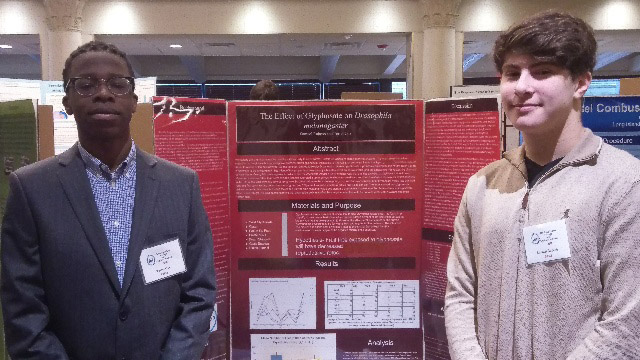
Terrel Cox and Samuel Roberts at the Crest Hollow with their project.
Weed killers are chemical or natural remedies used to kill unwanted weeds or plants on one’s property. They are used by millions daily, but recently this has raised some questions. The main chemical active ingredient in weed killers is a non-selective herbicide called glyphosate. A non-selective herbicide is a chemical that will kill most plants it is exposed to. This means weeds and the plants around it. This is why so many questions are raised. If this chemical kills most plants it comes in contact with, what is its effect on native wildlife? What is its effect on the ecosystem? This is why we are testing the chemical on Drosophila melanogaster or the common fruit fly. The fruit fly is a primary consumer and a major part of the food cycle and ecosystem. Furthermore they reproduce very quickly and have relatively short life spans. The fly is the perfect specimen to test glyphosate and see its effects on the lifespan and reproductive rates of the flies.
The Physical Effects of Reddit Posts under the Frisson Category
By Mya Davis
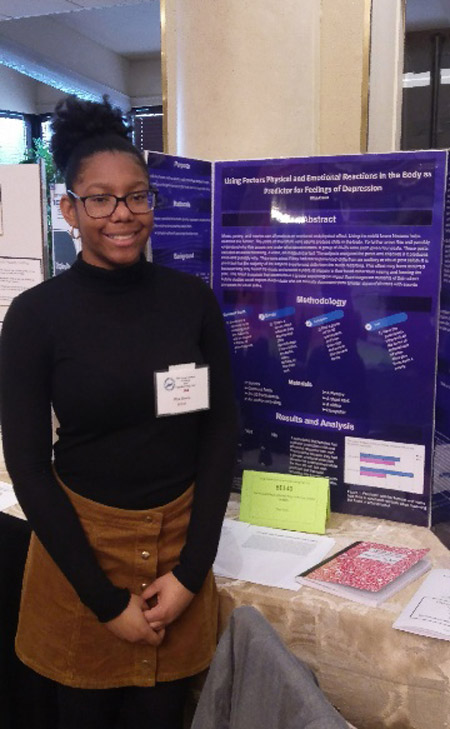
Mya Davis stands near her project at the Crest Hollow Country Club in Woodbury.
Music, poetry and movies can all produce an emotional and physical effect. Using the Reddit forum Frissions helps examine this further. The posts on this forum were said to produce chills in the body. To further prove this and possibly understand why this occurs and under what circumstances, a group of 20-25 were each given around four posts. These posts include an audio recording, a video, an image and a text. The subjects analyzed the posts and checked if it produces chills and possibly why. They were also asked if they have ever experienced chills from an auditory or visual post before. It was discovered that the majority of the subjects experienced chills from the audio recording. This could be because instead seeing and hearing the post, they only heard the music and created a piece of imagery in their head. The imagery matched with the music they were listening to and created chills.
Exploring a Potential Method to Increase Collagen Biosynthesis in Lumbricide
By Matt Gennarelli
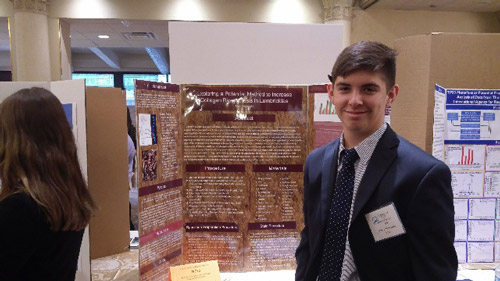
Matt Gennarelli with his science research project at Crest Hollow.
Collagen is a fibrous protein that allows tissues to withstand stretching and makes up about 30% of the protein in our bodies. The purpose of this experiment was to find a way to increase the production of collagen in lumbricidae by using various amino acids, expecting that proline would have the most dramatic effects. The other amino acids that were tested include glycine, lysine, glutamine, ornithine, serine, threonine, glutamic acid and aspartic acid.
To determine the amount of collagen in each lumbricidae, a sectioning was created of the specimen after allowing them two weeks to ingest the amino acids. The sectioning was then stained with sirius red and fast green dyes, which adhere to collagenous and non-collagenous proteins respectively. It was then put in a spectrophotometer using wavelengths of 540 nm and 605 nm, the absorption of each stain. The optical density was recorded for each trial. The specimen with a higher optical density at 540 nm reflect a greater concentration of collagen, as that would mean that a significant amount of red dye had found collagen to bind to. High optical density values at 605 nm would reflect the amount of non-collagenous proteins.
After following this procedure, it is expected that proline will have the most positive effect, as it is essential in the biosynthesis of collagen. If this is true, this research could be applied future experiments in medicine, agriculture, and cosmetics.
The Effect of Introducing Antennarius Pictus into a Symbiotic Relationship Involving
Amblyeleotris aurora and Alpheus bellus
By Robert Jean-Gilles
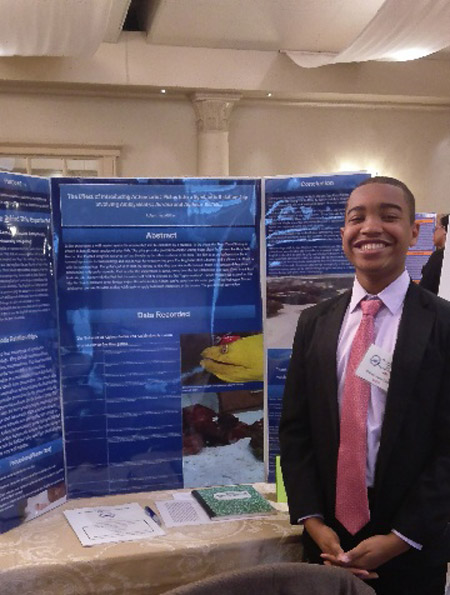
Robert Jean-Gilles with his project at the Crest Hollow.
In this experiment, a marine symbiotic relationship will be observed with the introduction of a natural predator. This experiment looked to see how the relationship remain stable if one organism is not present for this relationship. Such data can explore the effect of environmental stressors on the symbiotic relationships of aquatic organisms.
The Effects of Ocean Acidification on the Mortality Rate of T. weissflogii
By Michael McCooey
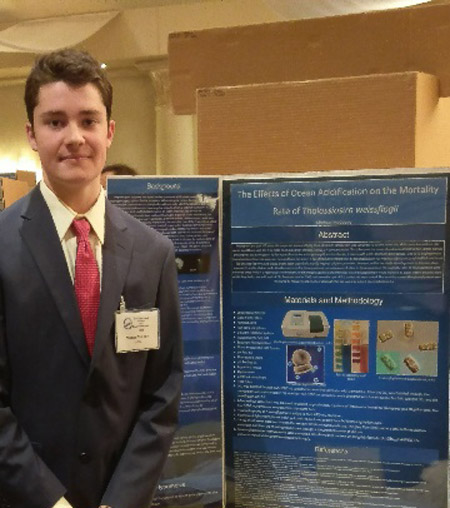
Michael McCooey with his project at the LI Science & Engineering Fair.
Throughout the past 200 years, the ocean has been acidifying at an alarmingly steady rate and continues to acidify to this day. If this were to continue, the ocean would have a pH of 7.67 by 2100! This is because the ocean absorbs almost half of the carbon dioxide emitted into the atmosphere. It has already been found that ocean acidification has negative effects on larval shellfish and larval fish. In this experiment, the mortality rates of phytoplankton were observed when living in a highly acidic environment. It was hypothesized that the mortality rate of phytoplankton would increase as ocean waters became more acidic. Four tanks, two with a pH of 7.67 and two with a pH of 8.07, were tested. The mortality rate of the phytoplankton were measured by measuring the levels of chlorophyll in the water. The hypothesis previously stated was supported, and as acidity increased, Mortality rate was increased.
Pattern Recognition in MRI Images Using a Simulated Neural Network
By Foster Sullivan
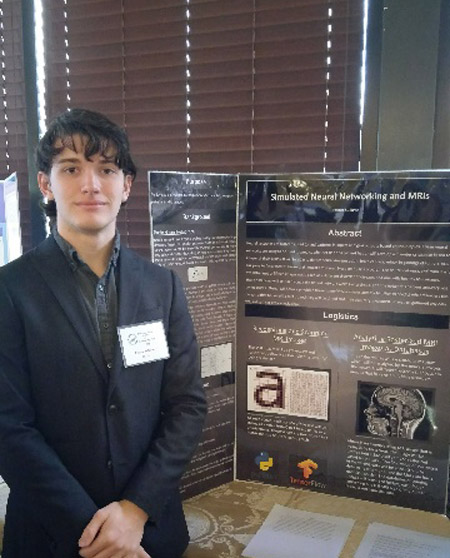
Foster Sullivan with his project at the LI Science & Engineering Fair.
Neural networks are currently used to find patterns in inputs and give outputs based on their inputs. These neural networks are going to be used to predict whether or not a patient has or will develop a disorder or disease based MRI images of their brains. It will be able to detect neural degeneration, brain cancers, minor beginnings of tumors, etc. I am going to first research the neural network this year. Next year, I will program the neural network and train it with five databases of fifteen images each; each of a different disorder or disease and one with healthy MRI images. These databases will be run through the neural network while being timed and the network’s percent of accuracy will be measured. Then, I will show a physician these same fifteen images and ask him/her to predict what disorders this person either has or will develop and they will be timed and their accuracy measured. I have not gathered any data yet, so I cannot draw conclusions.
The Effect of Mindfulness Meditation on
Student’s Cognitive Ability to Retain Information
By Claudia Villatoro

Claudia Villatoro competed at the Crest Hollow in the LI Science & Engineering Fair.
Mindfulness is a movement by movement awareness of our thoughts, feelings, bodily sensations and surrounding environment. Also, mindfulness involves acceptance, meaning that we pay attention to our thoughts and feelings without judging them for instance, that there’s a “right” or “wrong” way to think or feel in a given moment. When practicing mindfulness, our thoughts tune into what we’re seeing in the present moment rather than the past or imagining the future. Many Americans practice mindfulness in schools, prisons, hospitals, veteran centers and several other public places. The goal of this study is to see if mindfulness meditation has an impact on the test grades on students. Mindfulness could be used throughout schools to get better test grades and for students to not stress.
(Huntington High School sophomore Claudia Villatoro, a science research program participant provided reporting for this story.)
